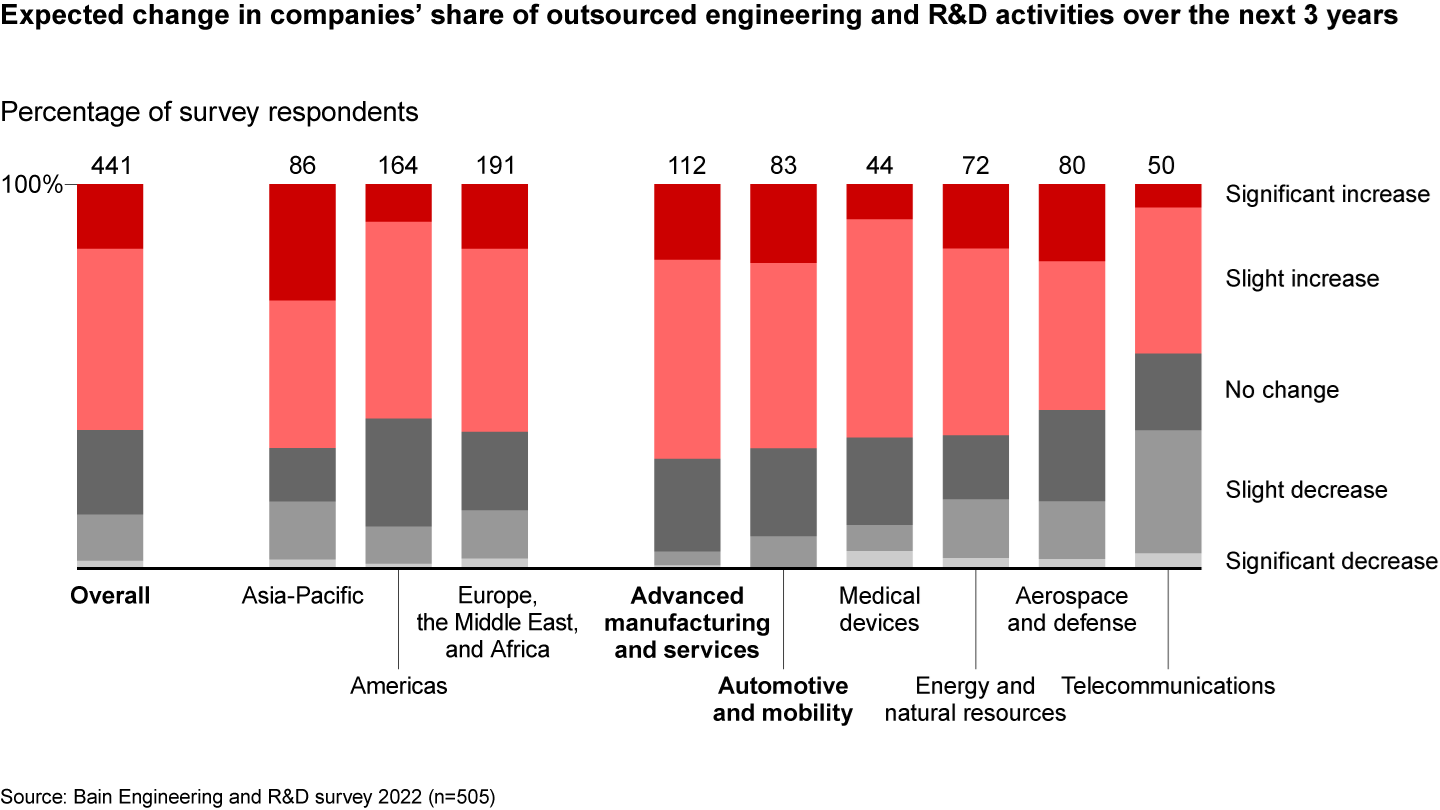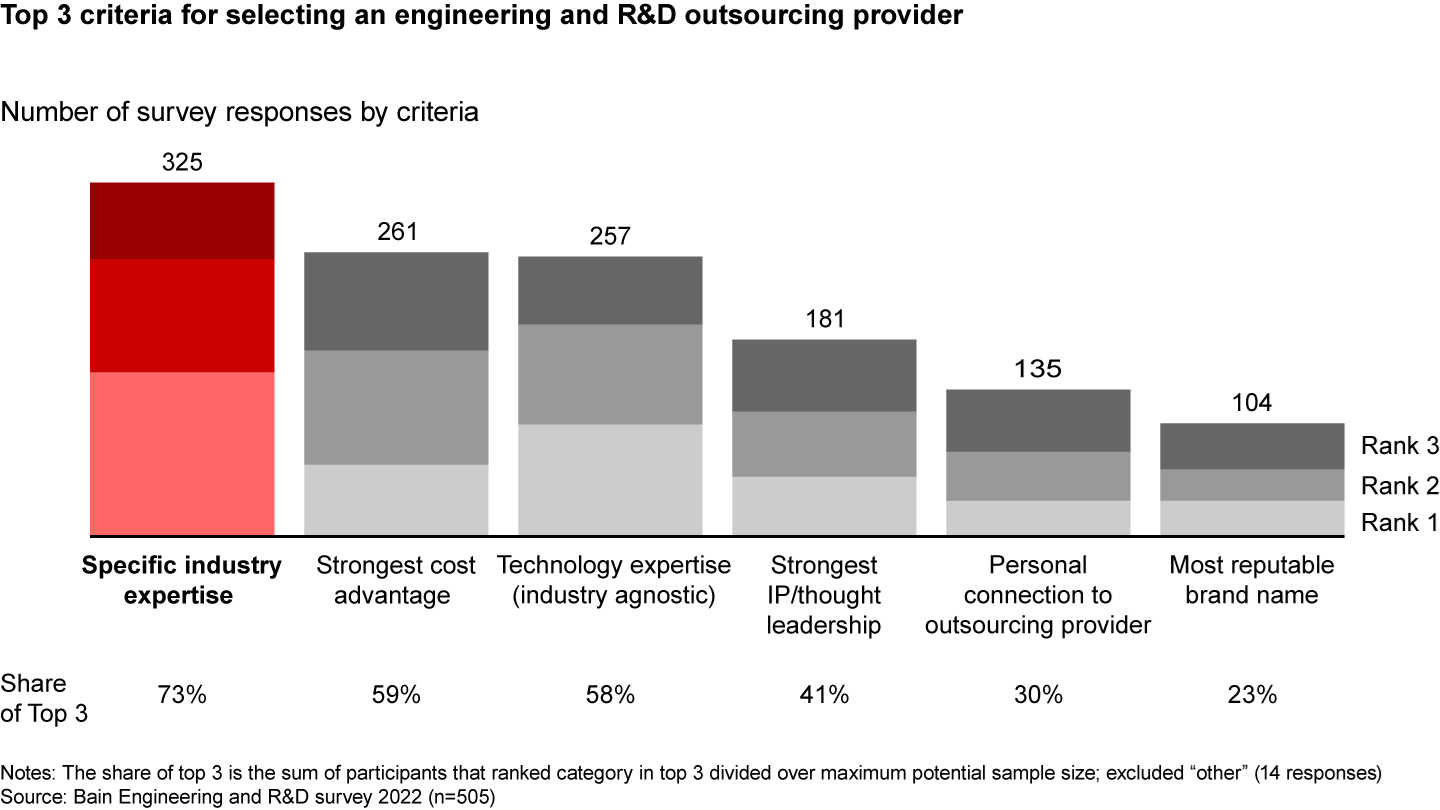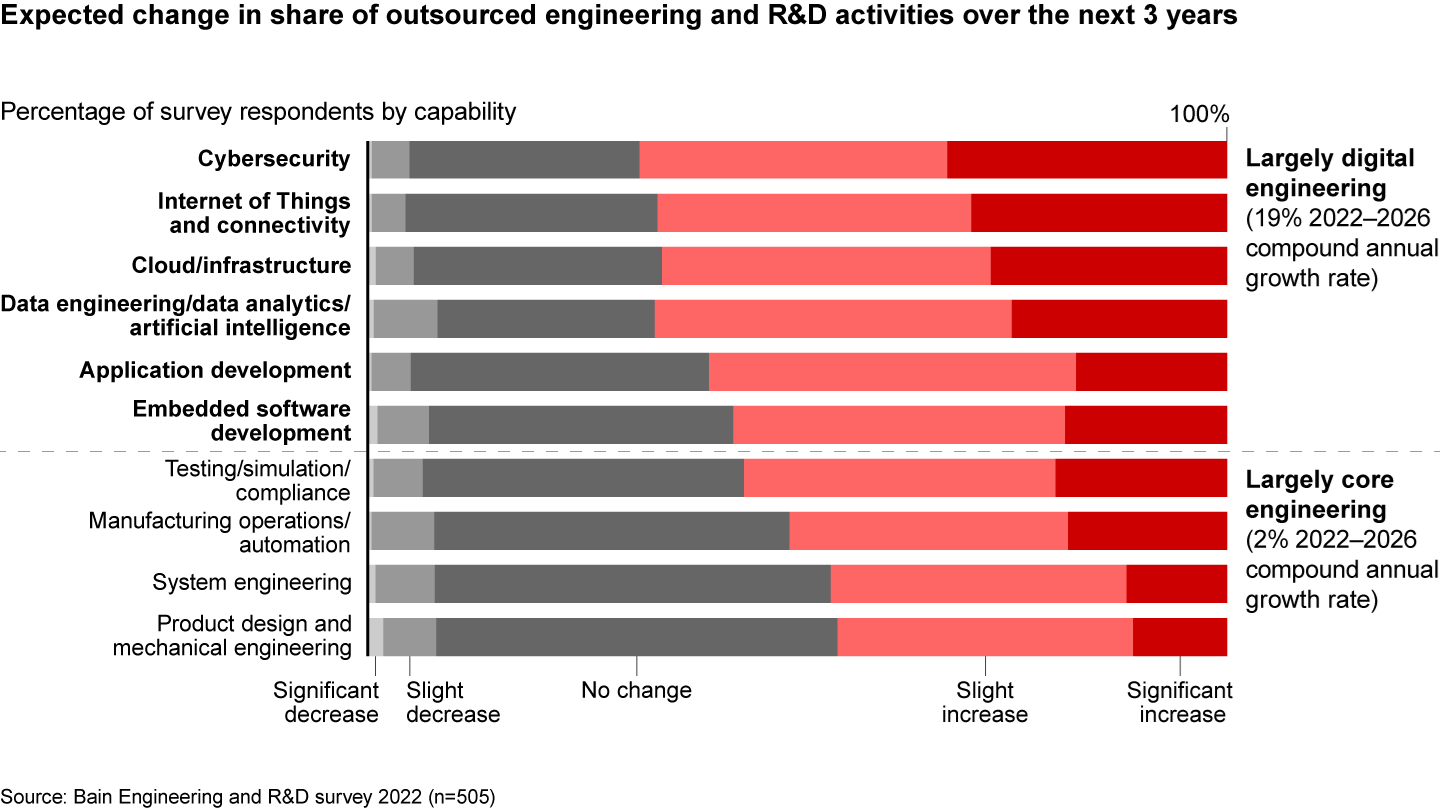Engineering and R&D Report

Executive Summary
- Bain research shows 60% of engineering executives plan to increase outsourcing over the next three years.
- In a strategic shift, companies are outsourcing a wider scope of activities, including full programs, instead of augmenting staff.
- The most important factor in choosing an outsourcing partner is expertise, not cost, Bain survey results show.
This article is part of Bain's 2023 Engineering and R&D Report.
As engineering and R&D (ER&D) organizations seek to innovate faster amid a talent shortage, many are opting to outsource and offshore an unprecedented proportion of work once done in-house. Leading companies are using outsourcing to overtake rivals in the innovation race by boosting value creation and accelerating time to market. Flexible labor pools help them respond faster to surges in demand, access missing capabilities, and free up in-house talent for more complex projects.
Signaling a strategic shift, 60% of companies plan to increase ER&D outsourcing over the next three years, according to a recent Bain survey of more than 500 senior engineering executives (see Figure 1). Similarly, 60% of respondents said they plan to shift work offshore or nearshore in the same period. Historically, large engineering or research-dependent companies have outsourced about 18% of ER&D work by value. That level is far lower than that in the IT services sector, which went through a similar transformation in the 2000s and now outsources 46% of activities. The level of offshoring and nearshoring in ER&D is also significantly lower than it is in IT services.
More than 60% of senior executives expect to increase the engineering and R&D activities they outsource


What work does ER&D include? For our study, we define it as activities aimed at developing new products and services and improving existing ones. Traditionally, ER&D includes early foundational research, design testing and verification of products, infrastructure (for example, a manufacturing plant), and post-production support. An emerging group of leaders are also investing in ER&D as a strategic capability that can support innovation and reinvent business models. As part of that approach, many are reconfiguring their products as outcome-based services and solutions that allow customers to pay based on negotiated results, such as machine uptime.
In addition to accelerating innovation, outsourcing and offshoring also help leadership teams address chronic talent shortages and mounting cost pressure. More than 80% of the senior executives we surveyed report talent gaps in areas requiring digital expertise, including data engineering, data analytics, artificial intelligence, cybersecurity, the Internet of Things (IoT), and connectivity, but also in other crucial areas such as systems engineering. Underscoring that trend, 73% of respondents said industry or technology expertise is the most important factor in selecting an outsourcing partner. That compares with 59% of respondents who cited cost as the No. 1 factor (see Figure 2).
Industry expertise is the most important factor for engineering and R&D executives when choosing an outsourcing provider


Digital engineering
ER&D outsourcing is growing in all areas of expertise covered by the survey, and the type of outsourced work is changing. Companies are also seeking new capabilities from service providers. In the past, demand focused primarily on mechanical and core engineering skills. Today, executives plan to invest significantly in digital engineering capabilities, particularly cybersecurity, IoT, cloud, embedded software, and data engineering and analytics (see Figure 3).
Engineering and R&D leaders anticipate the sharpest outsourcing growth in cybersecurity, Internet of Things, and cloud activities


Software talent gaps fuel offshoring because global markets have deep pools of digital talent and software is easy to develop and deliver from remote locations. At the same time, companies are outsourcing legacy disciplines that are often less strategically relevant for original equipment manufacturers (OEMs). Many service providers have significantly optimized legacy operations such as mechanical engineering, testing, simulation, and compliance.
The use of ER&D service providers varies by industry. Our research shows the sectors most inclined to increase outsourcing over the next three years are advanced manufacturing and services, automotive and mobility, medical devices, energy and natural resources, and aerospace and defense.
Finally, the types of projects are changing. Historically, large research organizations have mainly outsourced activities like testing, validation, and compliance while keeping core systems and products in-house. Now, the same companies are outsourcing a wider scope of activities, such as the end-to-end design of products or the development of key components such as combustion engines, traditionally a vital capability of automotive OEMs. While combustion engines still represent a large commercial market, OEMs are shifting their ER&D resources to next-generation electric power trains and new areas such as software-defined vehicles—including self-driving and connected cars—that can continually be upgraded. Many OEMs and Tier 1 suppliers are looking for partners to increase their software engineering capabilities.
Risk sharing
At the same time, ER&D-focused companies want outsourcers to take on more responsibility. Of companies already outsourcing, 60% of respondents said that they are increasingly switching from traditional staff augmentation (“body leasing”) to engagement models, in which service providers assume a larger role managing the project and share risk.
Engagement contracts may include full work packages or products such as the complete development of a smart watch.
In a similar move, Rolls-Royce Holdings shifted part of the civil aerospace engineering work from its Bengaluru, India, operations to Infosys, which will provide high-end engineering and R&D services integrated with advanced digital capabilities. By outsourcing that work, Rolls-Royce aims to benefit from an influx of new capabilities while reducing its costs.
In practice, the engagement model varies in scope. In more hardware-dominated engineering areas, upstream processes for engineering and R&D services, such as concept design and architecture, require a smaller staff but greater expertise and closer proximity to the client. Downstream processes, including detailed engineering and testing, require a larger staff but slightly less expertise, and the outsourcer does not need to be close to client sites. As companies adjusted working practices in response to Covid-19, many in-house teams began challenging the notion that service providers need to be in close proximity, increasing the opportunities for outsourcing.
Getting results
Engineering outsourcing and offshoring, once tactical solutions, are now strategic moves that help companies respond to innovation and cost pressures. Executives at leading ER&D-focused organizations follow a few important strategies to get the best results from outsourcing and offshoring:
Dare to outsource. Make a courageous decision about the activities that are not core to innovation and differentiation. Evaluate where the speed of closing capability gaps outweighs the importance of doing the work in-house. BMW, for instance, outsourced its next-generation charging electronics program to KPIT, a service provider specializing in vehicle electrification engineering and software. While the hardware and software that manage the battery and its use are core elements of the electric power train, outsourcing them can help BMW accelerate time to market. For companies lacking in-house capabilities, outsourcing components and modules can shorten development times by more than half.
Build an ecosystem of partners. Select three to five service providers with a strong partnership approach. Supplement this core group with smaller specialists in areas that require niche expertise. Reducing the total number of service providers helps both parties build higher-quality relationships. That, in turn, leads to greater efficiency and better pricing. It also opens the door to outsourcing larger projects.
Increase use of attractive outsourcing models. Companies that outsource entire engineering work packages, which include deliverables such as data, drawings, and models, often find that approach to be more economical than augmenting staff. For example, in workloads like technical documentation and aftermarket support, the dominant commercial model is based on the unit of work (fee per document, depending on complexity), as opposed to the number of engineers deployed. Outsourcing entire packages gives business leaders more predictable costs and allows service providers to deliver the benefits of standardization, automation, and an integrated global delivery model.
Coinvest with service providers for the long term. Jointly identify new outsourcing locations, both onshore or offshore, including centers of excellence. Investing together can help attract talent and rapidly build new capabilities. Coinvesting requires senior managers to commit to a strategic relationship. Leading companies ensure their teams have on-the-ground knowledge of local regulations, talent, logistics, and cultural issues. A good service partner can accelerate results and provide greater certainty of outcomes. One global tech service provider established a hub for Airbus in Bengaluru to support a platform-based approach in product development. That move gave Airbus access to new talent pools and reduced its costs.
For engineering and R&D service providers, the strategic shift toward outsourcing will provide huge opportunities in the coming decade. Leaders are likely to see annual revenue growth of 20% to 25% a year. However, meeting that surge in demand poses challenges. The emerging leaders have differentiated domain expertise, leading-edge engineering processes, and attractive employee value propositions. They also focus on a few strategic imperatives:
Become a talent magnet. Make employee experience a top priority. In a supply-constrained market, firms with the best track record in hiring and retaining talent have a significant advantage. Leaders ensure compensation packages reward those with scarce skills rather than just rewarding them based on tenure. They also create a flexible working environment and provide career path transparency and global mobility, which are increasingly important factors for young professionals.
Combine digital and domain expertise. Many firms offer generic digital services today, but few can combine sector-specific engineering domain and digital expertise. Our research shows that out of a company’s total spending on digital engineering, more than 50% requires knowledge particular to an industry domain. For example, engineers need knowledge of aerospace engines to help build digital twins of those engines.
Develop a scalable operating model. Winning firms punch above their weight by combining cost and capability advantages. This requires large-scale offshore locations, an ecosystem of partners (e.g., semiconductor integrated device manufacturers, open-source consortia, and cloud service hyperscalers), and the ability to sell and deliver global projects. Engineering services firms that are still predominantly focusing on staff augmentation will need to build capabilities in project management, continuous performance improvement, and new pricing models.